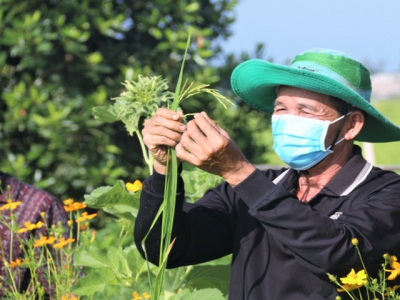Ecological model reduces costs and improves landscapes

Many farmers in the Mekong Delta region have implemented a 'rice fields with flower bank' model that helps to cut costs and beautify the sceneries of the rural areas.
The "rice fields with flower bank" model will attract useful insects to attrack harmful worms. Photo: Pham Hieu.
Farmer Kieu Van Lien from Phu Hoa Hamlet, Phu Huu Commune, An Phu District in An Giang Province is one of them. He has cultivated rice following the ecological model of “rice fields with flower bank” on a total area of nearly 2 hectares.
Consequently, the crop could still produce stable yield while the production costs have been significantly reduced.
"By planting flowers along the bank of the field, I have saved about 3 million VND/ha thanks to less need to spray pesticides and planthoppers", Lien said.
The model, in which farmers grow flowers along rice field bank to entice useful insects to eat harmful worms and increase their productivity, has also proved its effectiveness in other Mekong Delta provinces, like Tien Giang.
According to Nguyen Van Tuan from Tan Vinh Hamlet, Tan Hoa Thanh Commune, the model is a good way to reduce costs when the prices of fertilizers and pesticides are currently high.
“Prior to the application of the model, my family used to spray the fields 7-8 times with herbicides and insecticides that cost us several million VND/ha. Now the model has helped us to save such spending while creating beautifully colorful countryside,” he said.
The model of "rice fields with flower bank" has also been conducted in many northern provinces, especially the new rural areas.
“My family cultivates three hectares of rice and then we plant a variety of flowers along the bank of the field after sowing for about two weeks,” said Duong Minh Nga from Van Thanh Commune, Yen Thanh District, Nghe An Province.
“The flowers that attract useful insects that eat harmful insects the most include cosmos, Gerbera, butterfly pea flowers, sunflowers and daisies.
“When those flowers are in full bloom, their scents and colors attract many kinds of useful insects such as ladybugs, parasitic wasps, spiders, among others. These animals will destroy harmful insects, helping to reduce the use of pesticides and increase rice yield,” he said.

The prices of fertilizers and pesticides are currently high, so "rice fields with flower bank” is a good way to reduce costs. Photo: Pham Hieu.
However, “rice fields with flower bank” is not a new model.
It was piloted by the International Rice Research Institute (IRRI) during the 2009-2010 Winter-Spring crop in Cai Lay and Cai Be Districts of Tien Giang Province.
The model aims to improve the botanical system in rice fields to increase their ecological resistance and reduce the use of pesticides during the early stage of rice cultivation.
It also helps to limit the use of pesticides, reduce costs for farmers, and protect human health and the environment.
In recent times, this model has been increasingly widely applied and obtained many positive results.
The flowers planted around the field are diverse, but particularly white and yellow flowers that produce much pollen attracting more useful insects that eat harmful pests.
Useful insects like spiders, ladybugs eat pests such as leaf rollers, planthoppers, spider mites and therefore help to save spending on pesticides.
Both local farmers and technical staff have highly appraised the effectiveness of the model.
According to Tran Thi Thien Huong, head of the agriculture section of Ba Ria – Vung Tau Provincial Agricultural and Fishery Extension Center, the model helps reduce environmental pollution, create ecological balance in the fields, protect farmers’ health, and improve their technical know-how, and disease control in rice fields.
“Farmers in the Mekong Delta region have applied the model to grow flowers around their rice field. This has created a good ecological environment, reduced epidemic diseases in rice fields, and improved product quality.
“It is a breakthrough for rice field restructuring which reduces harmful pesticides, preserves the natural environment, develops agriculture sustainably, and boosts people’s incomes,” she added.
According to the Department of Crop Production under the Ministry of Agriculture and Rural Development, this model improves farmers’ saving at a time when the prices of fertilizers and pesticides are increasing so it should be widely implemented across the country.
In addition, to further reduce production costs, the department recommended that the farmers combine "1 must 5 reduction" measures such as: reducing varieties, reducing fertilizers, reducing chemical drugs, reducing irrigation water and reducing postharvest losses. Thanks to a harmonious combination of factors, farmers can reduce 1-2 doses of fertilizers and pesticides while still achieving high yields.
Related news
 A new approach needed for humane farming
A new approach needed for humane farming Vietnam’s Law on Livestock has provisions on humane farming and animal welfares which are still very new in the country.
 Vertical farming is headed for the ‘trough of disillusionment’
Vertical farming is headed for the ‘trough of disillusionment’ It’s October 15th, 2021 and my phone starts blowing up: “Did you see this!?” asks one vertical farming executive in a text.
 Building the brand for Vietnam's agricultural extension
Building the brand for Vietnam's agricultural extension On the road to building rural areas into a livable place, the Minister believes that the soft values from agricultural extension activities will create a new